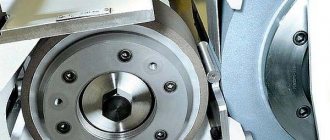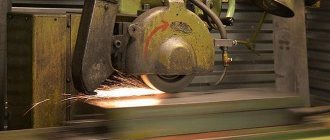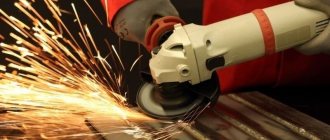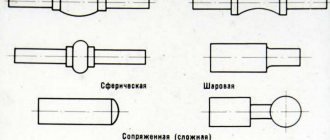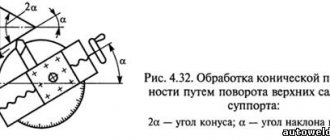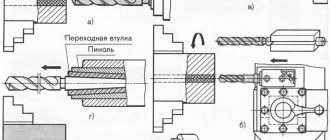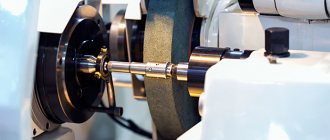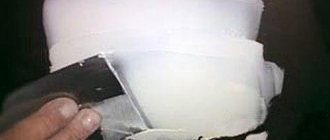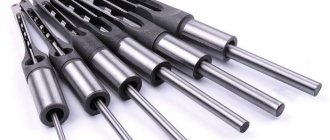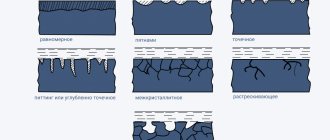Processing of metals in electrolyte
Electrochemical processing of metals using special equipment allows you to change the shape, size, and obtain a surface with low roughness. The material is not subjected to mechanical stress. It dissolves in the electrolytic composition under the influence of a current of a given value.
ECHO circuit
Advantages of the method
Methods for electrochemical anodic processing of metal products are developed for cases in which the use of other technologies does not give the desired result or is difficult. The uniqueness of the result of using the method:
- maintaining the shape of the working body;
- independence from the hardness/brittleness of the material;
- absence of deforming forces on thin walls;
- preservation of the surface of the part (thermal strengthening, melting, hardening);
- accessibility of influence in narrow cavities, complex transitions of planes, inclined grooves, holes of small cross-section at great depth (ratio 1:200);
- adjusting the intensity of exposure.
Process components
Electrochemical processing of metals is based on the leaching of the anode substance in an electrolytic solution at a certain current density between the electrodes. Machines for it have a narrow specialization (1.2 operations), depending on what processing technology is used. They manufacture individual equipment for a specific product.
Working environment
The solution is made up on a water basis from the appropriate components:
- sodium salts;
- potassium salts;
- acids (hydrochloric, sulfuric, nitric).
The concentration of salts is from 5% to 15%, acids are 5% - 10%.
Processing of individual parts of the workpiece is carried out, localizing the process in the desired area by applying protective masks to the rest of the part.
The products of the process are removed from the reaction zone by a flow of electrolyte.
Working solutions contain active reagents, so at the same time they carry out a set of measures to protect equipment and products from corrosion.
Introduction
The rapid development of science and technology in recent decades has necessitated the creation of new materials with high hardness, strength, heat resistance and corrosion resistance. Such materials include high-strength and stainless steels, heat-resistant alloys, magnetic alloys, hard alloys, semiconductors, etc. Processing such materials using traditional cutting methods (see Metal-cutting machines and tools) is associated with great difficulties and sometimes is impossible.
Under these conditions, it is advisable to use electrophysical and electrochemical processing methods.
Their advantages are as follows:
1) mechanical loads are either absent or so small that they practically do not affect the total processing accuracy error;
2) allow you to change the shape of the processed surface of the workpiece (part);
3) allow you to influence and even change the state of the surface layer of the part;
4) hardening of the treated surface does not form;
5) no defective layer is formed;
6) surface burns caused by grinding are removed;
7) increase: wear resistance, corrosion resistance, strength and other performance characteristics of the surfaces of parts.
The kinematics of shaping the surfaces of parts using electrophysical and electrophysical processing methods is, as a rule, simple, which ensures precise control of processes and their automation.
The machinability of parts by such methods (with the exception of ultrasonic) is not affected by the hardness and viscosity of the part material.
Type of processing
The anode connection of the product is performed during the following operations:
- Polishing. Obtaining a smooth surface, mirror, protective oxide film;
- Etching. Cleaning before painting, assembly, gluing, spot welding. Obtaining relief by localizing the action;
- Hole stitching, high precision cutting;
- Processing to size, copying according to the sample on the electrode.
By combining anodic (dissolution) and cathodic (sputtering) processing methods, high-tech products are obtained for various fields of application.
Performance
The machine has a process speed for removing a layer of material that is lower than that of mechanical equipment. The gain of time is that the final result, in terms of complexity and consistency of shape, is comparable to the work of 5 milling machines.
The productivity value is determined as the volume of material removed (mm³) per unit of time (min) with an applied current of 1 A. Each electrolyte composition has its own indicator. Sodium chloride, for example, has a value of 2.2 mm³/min, sodium nitrate – 1.1 mm³/min. The use of a composition of several reagents increases the rate of anode dissolution and increases the degree of processing.
It is necessary to maintain the established gaps (lateral, end) between the electrode and the workpiece. Voltage, feed rate, design of the working body, and electrical conductivity of the solution are taken into account.
Productivity is increased by using multi-electrode methods on the part area.
cutting
An increase in current density leads to a more intense process of metal removal from the surface. By aligning the dissolution rate with the cathode feed, a continuous process of cutting grooves in the material is obtained. The removal of reaction products is ensured by a continuous flow of pumped liquid. The electrode is a wire that is rewound from one drum to another.
Stitching
The method is similar to cutting, but the electrochemical process occurs mainly at the end of the cathode, which is fed at an equal speed. In this operation, the electrode must have sufficient rigidity so as not to perceive vibration that can be transmitted through the machine, and not to deform during movement. Its working part helps maintain a steady flow of electrolyte in the gap. Non-working edges are reliably insulated.
The processing accuracy of the metal plane is ±0.13 mm, holes 0.1 – 0.15 mm.
The machine can be equipped with a parameter monitoring system.
Copy
The shape of the electrodes in this case is the same. The gap is maintained at the calculated value. As a result of the electrochemical reaction, the material is loosened and washed out in mismatched places. At points where the gap is smaller, the process is more intense, the metal dissolves more strongly. As a result, the gap becomes the same, and the shape of the metals of the workpieces is electrochemically copied (with acceptable allowances due to the difficulty of control in a small gap). The accuracy of the achieved copying is from 0.5 microns to 3 microns, the repeatability of parameters is 0.5 - 10 microns from the electrode - the standard in the batch.
Universal versions of the machine for electrochemical processing of metals are common - copying and piercing machines with a wide range of products. Area of application: carbide processing: tools, dies, punches.
Dimensional
This technology is designed to obtain the required shape and size from a part. The procedure is carried out under the condition of high-speed, continuous renewal of the electrolytic environment in the area of action of the poles. Forced pumping is carried out under pressure created by the pump. A constant flow of liquid allows you to reduce the size of the gap between the metals being processed. The resistance of the medium decreases, the current density increases, and the electrochemical reaction accelerates.
Scheme 2
Anodic mechanical treatment
Sharpening
The features of electrochemical phenomena during the dissolution of metal edges are used. The tip is produced in an uneven electric field with constant movement. By adjusting the angle of inclination, sharpening of a given shape is obtained (tips, needles, electrodes). They mainly use sodium salts at a current density of 4-7 A/cm², voltage 8 - 15V.
Electrochemical processing technology
Method for electroabrasive grinding of internal surfaces of complex shape
The invention relates to electrical abrasive grinding of the internal surfaces of a complex-shaped hole in a part. In the method, electroabrasive grinding is carried out in three stages. At the first stage, the grinding wheel is radially cut into the workpiece surface by the amount of allowance, measuring the torque on the grinding wheel shaft and monitoring the second derivative of the residual stress with respect to time in pauses between voltage pulses. At the second stage, deep-feed equidistant grinding is carried out at a feed speed exceeding the speed of electrochemical dissolution, measuring the torque on the grinding wheel shaft and monitoring the second derivative of the residual voltage with respect to time in pauses between process current voltage pulses. At the third stage, the nursing process is carried out at process current voltages in a pulse higher than the transpassivation voltage of the processed material, while pulses of micro- or nanosecond duration are set, and the pause duration is selected from the condition of obtaining the greatest productivity. The invention improves the accuracy and quality of the machined surface and increases the productivity of processing the inner surface of holes of complex shape. 4 ill., 1 ave.
The claimed technical solution relates to combined methods of processing metals and alloys, combining electrochemical and mechanical effects on the surface being processed, in particular to electroabrasive grinding of internal surfaces, and can be used in mechanical engineering for electroabrasive processing of internal surfaces of round and non-circular shapes with different curvatures of the generatrices made from difficult-to-process conductive materials.
Electrical abrasive grinding is a combined process in which metal is removed from the workpiece as a result of simultaneous processes of anodic dissolution and mechanical cutting with abrasive grains. Due to the protrusion of abrasive grains from the grinding wheel bond, a gap is formed between the bond and the cutting surface with a length equal to the length of the arc of contact between the grinding wheel and the workpiece, which is filled with electrolyte. When electric current is passed through the gap, the surface of the anode (to which the plus of the current source is connected) acquires reduced strength properties. Additionally, anodic dissolution of part of the thickness of the cut layer of the workpiece occurs. Thus, the processed surface of a part during electroabrasive grinding is formed as a result of the electrochemical process and cutting with abrasive (diamond) grains, which remove anodic dissolution products and cut off the material being processed (article “Factors influencing the performance of electroabrasive grinding”, author E.V. Zhiltsov , internet site address https://science-bsea.narod.ru/2009/mashin_2009/jiltsov_faktor.htm https://science-bsea.narod.ru/2009/mashin_2009/jiltsov_faktor.htm) [1].
There is a known method of electroabrasive grinding, described in the USSR author's certificate No. 1237334 (MPK class B23H 5/06, B23N 5/14, priority date 01/07/1985) [2]. In this method, electroabrasive grinding of a part is carried out by the periphery of a rotating abrasive wheel on a conductive bond with the supply of electrolyte to the processing zone under pressure and with the regulation of the electrolyte flow rate. The flow rate of the electrolyte is adjusted to achieve the effect of a minimum content of gases in it, which makes it possible to increase the electrical conductivity of the electrolyte in the liquid wedge, that is, the layer formed between the grinding wheel and the workpiece.
However, this method cannot be used when processing the internal surfaces of parts with a complex shape, since the electrolyte according to this method is supplied to the processing zone through a nozzle, which is difficult when processing surfaces with a non-linear generatrix.
In addition, the use of electrolyte flow rate control for processing precision surfaces is not possible due to the high inertia of the electrolyte flow rate control system.
Another method of diamond-electrochemical grinding is described in the invention according to the USSR author's certificate No. 1701452 (class IPC V23N 5/06, priority date November 30, 1989) [3]. According to the method described in this invention, processing is carried out by applying a bipolar voltage (i.e., using positive and negative pulses of process current voltage) and controlling the magnitude and rate of change of power consumed by the tool drive. Direct polarity voltage is applied when the power Rash+(0.4-0.6)·(Rash-Reh) is reached, where Rash and Rakh are predetermined power values, respectively, for diamond and diamond-electrochemical grinding. A reverse polarity pulse is applied if the pause time between direct polarity pulses τi becomes less than (2.5-3) τi, where τi is the duration of the direct polarity pulse.
The disadvantages of this method are:
1. The need to use a negative voltage pulse of the process current to restore the cutting ability of the grinding wheel, which leads to rapid wear of the grinding wheel.
2. The need to make a large number of preliminary measurements Rash, Rach in various processes (during diamond grinding and diamond-electrochemical grinding on direct current).
There is a known method for controlling the process of electric diamond deep-feed grinding of carbide tools according to the USSR author's certificate No. 1148738 (class MPK V23N 7/18, priority date 07/13/1982) [4]. When using this method, during processing, the power on the spindle of the grinding wheel is measured, the ratio of values proportional to the power on the spindle and the current in the processing zone is determined, and during processing the feed amount is adjusted, maintaining at a given level the ratio of the power on the spindle to the current in the processing zone.
The disadvantage of this method is the inability to influence the pressing of a tool of limited rigidity and, consequently, the accuracy of processing during the processing of a part.
There is a known method for electroabrasive grinding of internal surfaces, set out in the USSR author's certificate No. 1516264 (class IPC V23N 5/06, priority date 01/14/1988) [5], which is closest to the claimed method and therefore accepted as a prototype.
According to this method, electroabrasive grinding of shaped internal surfaces occurs with control of the transverse feed of the grinding wheel. In the process of cutting into the wheel, the time derivative of the grinding power is controlled, while cutting in the wheel is carried out at a constant speed of its transverse feed until the predetermined value of the derivative is reached. At the moment of reaching a predetermined value of the derivative, the values of the components of the cutting forces are measured and the value of their ratio is recorded, which is taken as a reference and maintained in the process of further processing of the part by controlling the transverse feed.
The disadvantages of this known method are:
1. The complexity and high cost of methods and devices used to measure cutting forces and their ratio.
2. The value of the ratio of cutting forces (cutting coefficient η) does not affect the accuracy of processing associated with pressing out the tool when cutting forces (Py and Pz) reach significant values, which occurs as a result of an increase in the contact patch, since the ratio of cutting forces when introducing abrasive grains to a depth of no more than the thickness of the pre-fractured layer always remains constant due to the proportional change in cutting forces.
The problem to be solved by the proposed method of electroabrasive grinding of internal surfaces of complex shapes is to increase the accuracy, quality of the machined surface and increase processing productivity by optimizing electroabrasive grinding modes.
The problem is solved by a method of electroabrasive grinding of the inner surface of a hole of complex shape in a part, including filling the gap between the workpiece and the grinding wheel with electrolyte, supplying process current to the processing zone and processing the surface of the part with a rotating grinding wheel during its transverse feed, characterized in that electroabrasive grinding is carried out in three stages, at the first stage of which voltage pulses of process current are supplied to the processing zone, and the duration of the pause between voltage pulses is set to the smallest sufficient to control the second derivative of the residual voltage with respect to time, and the amplitude of the voltage pulse is chosen to be the maximum possible depending on the grain size of the grinding wheel , and carry out radial incision of the grinding wheel into the surface being processed by displacing the part by an allowance amount with an incision speed exceeding the speed of electrochemical dissolution, while measuring the torque on the grinding wheel shaft and monitoring the second derivative of the residual stress with respect to time in pauses between voltage pulses, and when the second derivative of the residual stress is detected with respect to time, the infeed speed of the grinding wheel is reduced and the speed is restored in the absence of the mentioned second derivative, and when the infeed depth is reached equal to the allowance value, half of the highest torque corresponding to the highest infeed speed is remembered and the radial infeed is stopped, while at the second stage, voltage pulses of the process current are also supplied to the processing zone, the duration of the pause between the pulses is set to the smallest sufficient to control the second derivative of the residual voltage with respect to time, while the duration of the voltage pulse of the process current is reduced from the condition of achieving the least influence of leakage currents, and deep equidistant grinding of the workpiece surface at a feed speed exceeding the speed of electrochemical dissolution, while measuring the torque on the grinding wheel shaft and monitoring the second derivative of the residual stress over time in pauses between pulses of the process current voltage, depending on the presence or absence of the second derivative of residual voltage over time, the feed speed is reduced or restored, while maintaining the torque at the memorized level, and at the third stage, the nursing process is implemented at process current voltages in the pulse higher than the transpassivation voltage of the material being processed, while pulses of micro- or nanosecond duration are set.
The solution to the problem lies in the fact that in the known method of electroabrasive grinding, which includes filling the gap between the cutting surface and the grinding wheel with electrolyte, supplying technological current to the processing zone, cutting in the grinding wheel at a set speed of its transverse feed, and the cutting speed exceeds the speed of electrochemical dissolution, According to the claimed method, electroabrasive grinding of internal surfaces is carried out in three stages.
At the first stage, voltage pulses of the process current (hereinafter referred to as voltage pulses) are supplied to the processing zone, and the pause between pulses is set to the smallest, but sufficient to control the second derivative of the residual voltage with respect to time. The amplitude of the voltage pulse is selected as high as possible depending on the grain size of the grinding wheel, and the duration of the voltage pulse is selected based on the condition for achieving the highest processing productivity.
The workpiece is given a radial displacement to cut the grinding wheel into its workpiece surface by an allowance amount with an cutting speed exceeding the speed of electrochemical dissolution, measuring the torque on the grinding wheel shaft and monitoring the second derivative of the residual stress with respect to time in pauses between pulses. The cutting-in speed of the grinding wheel is reduced when the second derivative of the residual stress with respect to time is detected and the cutting-in speed is restored in the absence of the second derivative. When the infeed depth is reached equal to the allowance, half of the maximum torque corresponding to the highest infeed speed is stored and the radial infeed is stopped.
At the second stage, voltage pulses of the process current are supplied to the processing zone, and the pause value between the voltage pulses is set to the smallest, but sufficient to control the second derivative of the residual voltage with respect to time. The duration of the voltage pulse is reduced in order to achieve the least influence of leakage currents, and the amplitude of the voltage pulse is set sufficient to ensure the greatest processing productivity.
Deep-feed equidistant grinding is carried out at a feed speed exceeding the speed of electrochemical dissolution, measuring the torque on the grinding wheel shaft and monitoring the second derivative of the residual stress with respect to time in pauses between voltage pulses.
The feed speed is reduced and then restored depending on the presence or absence of the second derivative of the residual stress with respect to time and the torque on the grinding wheel shaft is maintained at the stored level.
At the third stage, the nursing process is implemented at process current voltages in a pulse higher than the transpassivation voltage of the material being processed, while voltage pulses of micro- or nanosecond duration are set, and the pause duration is selected from the condition of obtaining the greatest productivity (feed speed).
The stages of the proposed method are illustrated in figures 1, 2, 3 and 4. In FIG. Figure 1 shows the position of the grinding wheel and the workpiece at the first stage; in fig. 2 - position of the grinding wheel and the workpiece at the second stage; in fig. 3 - graph explaining the implementation of the proposed method at the first stage; in fig. 4 - graph explaining the implementation of the proposed method at the second stage.
The first stage of processing the inner surface of the part (Fig. 1) occurs as follows. Initially, the internal cavity of the part (1) is filled with electrolyte (2) and the grinding wheel is turned on in the direction (ninstrument). Process current voltage pulses are supplied to the processing zone from a process current source (3). On the part (1) - plus, on the grinding wheel (4) - minus. In fig. Figure 1 shows the form of the applied voltage (5), where (τи) is the duration of the voltage pulse, (τп) is the duration of the pause between voltage pulses, is the operating voltage in the pulse, is the residual voltage in the pause. The pause between voltage pulses is set to the smallest, but sufficient to control the second derivative of the residual voltage with respect to time. The amplitude of the voltage pulse is selected as high as possible, depending on the grain size of the grinding wheel, and the duration of the voltage pulse is selected based on the condition for achieving the highest processing productivity.
To cut the grinding wheel into the part and measure the torque on the shaft of the grinding wheel, the grinding wheel (4) is radially cut into the part (1) by displacing the part (1) by the amount of allowance (t(k)), where k is the curvature of the machined surface, with an incision speed exceeding the electrochemical dissolution speed (Vecho), measuring the torque and monitoring the second derivative of the residual voltage with respect to time in pauses between voltage pulses. In this case, the cutting speed of the grinding wheel (4) into the part (1) is reduced when the second derivative of the residual stress with respect to time appears and the cutting speed is restored in the absence of the second derivative. When the infeed depth is reached equal to the allowance value (t(k)), half of the maximum torque corresponding to the highest infeed speed is memorized and the radial infeed is stopped.
Thus, at the first stage of processing, the grinding wheel is plunged into the equidistant grinding depth required in the future, equal to the allowance value (t(k)), the torque on the grinding wheel shaft is measured and stored, corresponding to the maximum spin value of the tool, at which the tolerance is not violated to the size of the machined hole.
At the second stage (Fig. 2), the duration of the voltage pulse is reduced from the condition of achieving the least influence of leakage currents, and the amplitude of the voltage pulse is set sufficient to ensure the highest processing productivity, deep-depth equidistant grinding of the part (1) is carried out at a feed speed (Vк) exceeding the speed electrochemical dissolution (Vecho), measuring the torque on the grinding wheel shaft (4) and monitoring the second derivative of the residual voltage with respect to time in pauses between voltage pulses. The feed speed (Vk) is reduced and then restored, depending on the presence or absence of the second derivative of the residual voltage with respect to time, and the torque is maintained at the stored level (Mmax).
In section A-A of Fig. 2 shows a fragment of obtaining a processed surface with a curved generatrix at the second stage of the proposed method of electrical abrasive grinding, where pos. 1 - part, pos. 2 — electrolyte, pos. 4 — grinding wheel, pos. 6 - surface obtained as a result of the second stage of processing, B - height (width) of the workpiece, ntool - direction of rotation of the grinding wheel.
The feed speed under conditions of equidistant grinding is the resulting speed when the part simultaneously moves in the direction of the X and Y axes (Fig. 2) at the speeds that are calculated by the machine control device. As a control device, for example, an industrial computer from Advantech with a set of standard ADC and DAC boards (ADC - analog-to-digital converter, DAC - digital-to-analog converter) is used.
Thus, at the second stage, the main part of the allowance of variable size is removed under the conditions of electrical abrasive grinding, which requires monitoring the absence of electrical erosion phenomena in the interelectrode gap and the amount of pressing of the grinding wheel axis associated with the variable grinding depth.
At the third stage, the nursing process is implemented at process current voltages in a pulse higher than the transpassivation voltage of the material being processed, while pulses of micro- or nanosecond duration are set, and the pause duration is selected from the condition of obtaining the greatest productivity (feed speed).
That is, at the third stage, the roughness and accuracy of the machined surface is improved under electrical abrasive grinding conditions.
All stages of the proposed method of electroabrasive grinding of internal surfaces of complex shape are implemented with guaranteed filling of the treatment zone with electrolyte.
As a result of the implementation of all stages of the proposed method of electroabrasive grinding of internal surfaces of complex shape, we obtain the required surface (item 6, Fig. 2), for example epitrochoids.
Application example
The inventive method was used when processing epitrochoids with a non-linear generatrix. In this case, the grinding wheel, performing a rotational movement at the speed of the main cutting movement, cut into the allowance amount. After which the part made an equidistant movement towards the machined surface, while the grinding wheel removed the main part of the allowance. During processing, the grinding wheel was plunged in, and then the equidistant feed movement of the workpiece was carried out at speeds greater than the speed of electrochemical dissolution.
In fig. Figure 3 shows graphs explaining the implementation of the proposed method of electroabrasive grinding at the first stage, where (τi) is the duration of the voltage pulse, (τp) is the duration of the pause between voltage pulses, is the voltage in the pulse, is the residual voltage in the pause, is the second derivative of the residual voltage in time (T), (L) - arc of contact of the grinding wheel with the workpiece. The workpiece is given a radial displacement with a cutting speed that is greater than the speed of electrochemical dissolution (Vecho), calculated in advance. As the part moves towards the grinding wheel, abrasive grains are cut into the cut layer, which reduces the interelectrode gap (the distance between the grinding wheel bond and the cutting surface). As the interelectrode gap decreases, its electrical resistance changes as a result of filling with anodic dissolution waste and parts of the cut layer (chips). On voltage-time (T) oscillograms, this phenomenon is observed in the form of a violation of the slope of the residual voltage (points a, f and m), which can be identified by the second derivative of the residual voltage with respect to time (points a1 f1 and m1). The appearance of points (a1 f1 and m1) indicates the need to begin the process of slowing down the penetration of abrasive grains into the cut layer by reducing the cutting speed (points a2, f2, and m2). The plunge speed decreases by a predetermined amount (point b). From this moment, the cutting speed becomes less than the speed of electrochemical dissolution (Vecho), which leads to an increase in the interelectrode gap and the disappearance of the second derivative of the residual voltage with respect to time. The absence of violations of the slope of the residual stress in the pause, as well as the second derivative of the residual stress with respect to time, at the beginning of the next pauses (points c and h) causes the restoration of the cutting speed, which will be restored to the cutting speed (points c1 and h1). The beginning of the recovery of the infeed speed occurs at points (c2) and (h2). With further movement of the part in the radial direction, the processes of braking the penetration speed and its restoration will be repeated. With a decrease in the penetration speed, a synchronous decrease in torque (M) occurs (points a3, f3 and m3), and an increase in the arc of contact (L), associated with an increase in grinding depth, causes an increase in torque (M), which reaches the limiting value (Mmax) at the greatest infeed depth equal to the allowance value (t(k)). When the part reaches its limit position, corresponding to the depth of penetration of the grinding wheel into the part, equal to the allowance value (t(k)), half of the maximum torque (Mmax) is stored and further radial displacement of the part stops.
The result of the first stage is the cutting of the grinding wheel into the part to a value at which further removal of the entire allowance (t(k)) will occur, as well as storing half of the maximum torque (Mmax) on the grinding wheel shaft, the value of which will be used at the second stage of processing .
The second stage of implementation of the proposed method is illustrated by the graphs in Fig. 4, where (τi) is the duration of the voltage pulse. At the second stage, deep-feed equidistant grinding of the part (1) is carried out at a feed speed (Vk) exceeding the speed of electrochemical dissolution (Vecho), calculated in advance. As the part moves in the direction of the feed speed (Vk), abrasive grains are cut into the cut layer, at which the interelectrode gap decreases. As the interelectrode gap decreases, its electrical resistance also changes as a result of filling with anodic dissolution waste and parts of the cut layer (chips). On voltage-time (T) oscillograms, this phenomenon is observed in the form of a violation of the slope of the residual voltage (points a and f), the beginning of which can be identified by the second derivative of the residual voltage with respect to time (points a1 and f1). The appearance of points (a1 and f1) indicates the need to begin the process of slowing down the penetration of abrasive grains into the cut layer by reducing the feed speed (Vк) (point a2 and f2). The feed speed (Vk) decreases by a predetermined amount (point b). From this moment, the feed speed (Vk) becomes less than the speed of electrochemical dissolution (Vecho), which leads to an increase in the interelectrode gap and the disappearance of the second derivative of the residual voltage with respect to time. The absence of violations of the slope of the residual stress, as well as the second derivative of the residual stress with respect to time at the beginning of the next pauses (points c and h), causes the restoration of the feed speed, which will be restored to the feed speed (Vk) (points c1 and h1). The beginning of the restoration of the feed speed (Vk) occurs at points (c2 and h2). With further movement of the part, the curvature of the profile of the processed surface changes, and at the same time an increase in the arc of contact (L) of the grinding wheel with the part and the number of abrasive grains in contact with the part, which leads to an increase in torque on the grinding wheel shaft. When the maximum torque value (Mmax) (point d) is reached, the feed speed (Vk) decreases (point d1). Further continuation of processing will be carried out with a limitation of the feed speed (Vk) based on the second derivative of the residual stress with respect to time with the imposition of a torque limit. The result of the second stage is cutting off the entire allowance while ensuring the specified processing accuracy with the highest productivity.
At the third stage, the nursing process is carried out at process current voltages higher than the transpassivation voltage of the processed material, while pulses of micro- or nanosecond duration are set, and the pause duration is selected from the condition of obtaining the highest productivity (feed speed).
The inventive method for electroabrasive grinding of internal surfaces of complex shape allows one to significantly increase the productivity and accuracy of processing by controlling the speed of incision of abrasive grains, and improve the machined surface by reducing the duration of the technological current pulse at the second stage, which helps reduce the influence of stray currents on the machined surface, and introducing a third stage of processing with an even greater reduction in the duration of the voltage pulse.
Thus, the obtained results became possible as a result of the operationally controlled process under optimal conditions.
The main advantage of this method should be considered a multiple reduction in cutting forces and especially the vertical component, due to which there is a significant reduction in wear on the working surface of the grinding wheel, as well as the depressing of its axis. As a result of reducing the wear of the grinding wheel and reducing the spin of its axis, it becomes possible to process holes with a non-linear generatrix using plunge-cut and deep-feed equidistant grinding with a tool of limited rigidity with a productivity commensurate with grinding external round and flat surfaces, without reducing the accuracy and quality of processing.
At the moment, internal surfaces of complex shape and with a non-linear generatrix are processed either manually, or on CNC coordinate grinding machines, or on electroerosive and electrochemical machines. The productivity of manual processing is extremely low and requires the use of highly qualified workers. The processing productivity on a jig grinding machine is 10-20 times lower, and processing accuracy is achieved through an extreme reduction in productivity and the use of high-rigidity machines, therefore, high weight and cost. In addition, there is a decrease in processing accuracy as a result of the use of additional working movements (oscillation) of the grinding wheel, which cause a decrease in accuracy. The cost of machines with a large number of movements of working parts is much higher than machines using plunge-cut and deep-feed equidistant grinding schemes. Their cost especially increases when it is necessary to process particularly precise surfaces. When using coordinate grinding machines to process complex surfaces with a non-linear surface, the cost of processing is several tens of times higher than when using electric abrasive grinding machines. The use of electroerosive and electrochemical machines is not effective, because... the former have low productivity and relatively high cost, while the latter, at an acceptable cost, have low productivity. Therefore, processing holes of complex shape with a non-linear generatrix is an extremely labor-intensive process.
INFORMATION SOURCES
1. Article “Factors influencing the productivity of electrical abrasive grinding”, author E.V. Zhiltsov, internet site address https://science-bsea.narod.ru/2009/mashin_2009/jiltsov_faktor.htmhttps://science-bsea. narod.ru/2009/mashin_2009/jiltsov_faktor.htm).
2. Author's certificate of the USSR No. 1237334 “Method of electrical abrasive grinding.”
3. Author's certificate of the USSR No. 1701452 “Method of diamond-electrochemical grinding.”
4. Author's certificate of the USSR No. 1148738 “Method of controlling the process of electric diamond creep-feed grinding of carbide tools.”
5. Author's certificate of the USSR No. 1516264 “Method of electrical abrasive grinding.”
A method for electroabrasive grinding of the inner surface of a hole of complex shape in a part, including filling the gap between the workpiece and the grinding wheel with electrolyte, supplying process current to the processing zone and processing the surface of the part with a rotating grinding wheel during its transverse feed, characterized in that electroabrasive grinding is carried out in three stages , at the first stage of which voltage pulses of process current are supplied to the processing zone, and the duration of the pause between voltage pulses is set to the smallest sufficient to control the second derivative of the residual voltage with respect to time, and the amplitude of the voltage pulse is selected as maximum as possible depending on the grain size of the grinding wheel, and is carried out radial incision of the grinding wheel into the surface being processed by displacing the part by an allowance amount with an incision speed exceeding the speed of electrochemical dissolution, while measuring the torque on the grinding wheel shaft and monitoring the second derivative of the residual stress with respect to time in pauses between voltage pulses, and when the second is detected derivative of the residual stress with respect to time, they reduce the cutting speed of the grinding wheel and restore the speed in the absence of the mentioned second derivative, and when the cutting depth is reached, equal to the allowance value, remember half of the highest torque corresponding to the highest cutting speed, and stop the radial cutting, while at the second stage, process current voltage pulses are also supplied to the processing zone, the duration of the pause between pulses is set to the smallest sufficient to control the second derivative of the residual voltage with respect to time, while the duration of the process current voltage pulse is reduced from the condition of achieving the least influence of leakage currents, and deep-feed equidistant grinding is performed the processed surface of the workpiece hole with a feed speed exceeding the speed of electrochemical dissolution, while measuring the torque on the grinding wheel shaft and monitoring the second derivative of the residual voltage with respect to time in pauses between process current voltage pulses, depending on the presence or absence of the second derivative of the residual voltage the voltages over time reduce or restore the feed speed, while maintaining the torque at the level of the stored one, and at the third stage, the nursing process is implemented at process current voltages in the pulse higher than the transpassivation voltage of the material being processed, while pulses of micro- or nanosecond duration are established.
